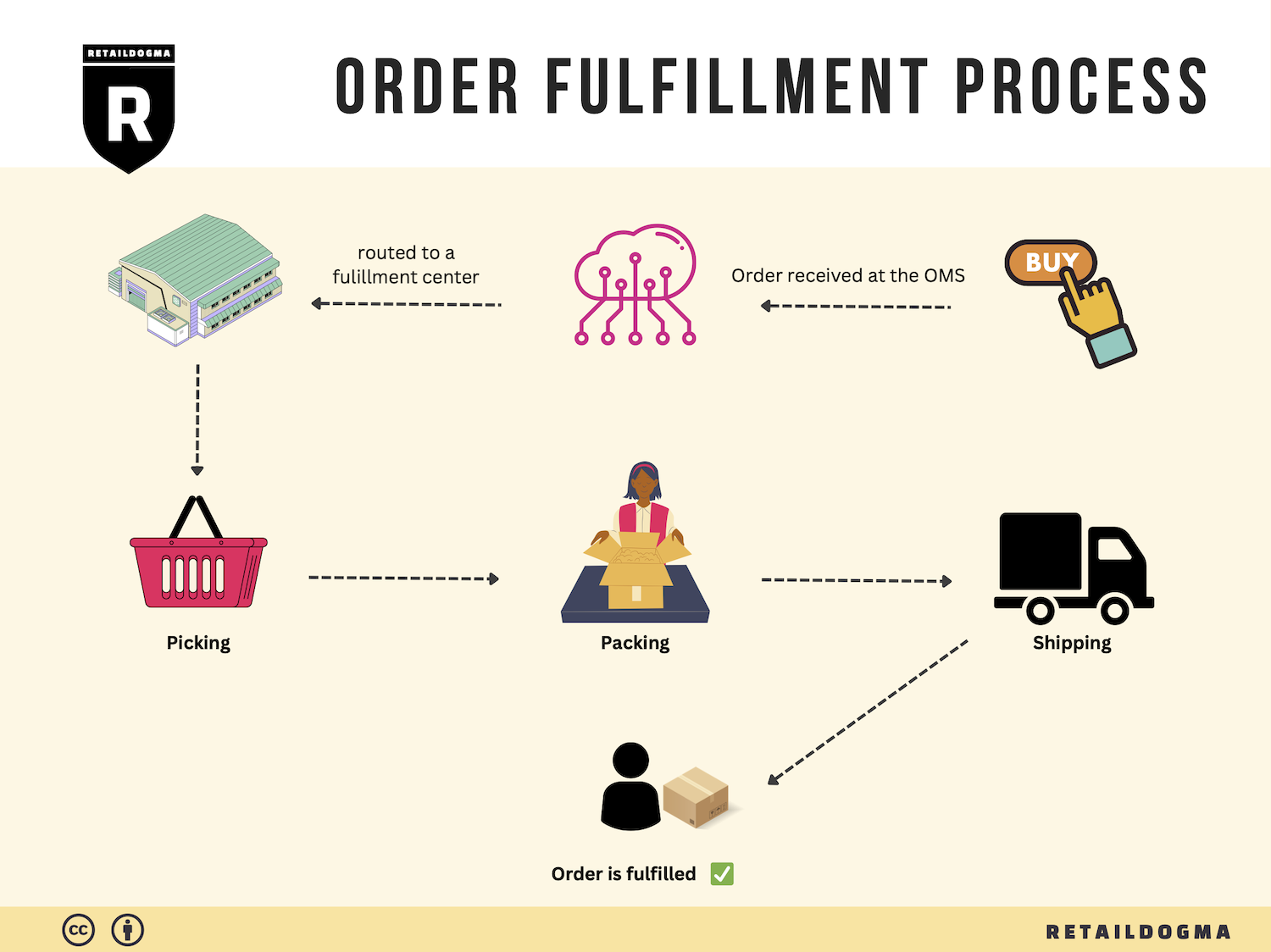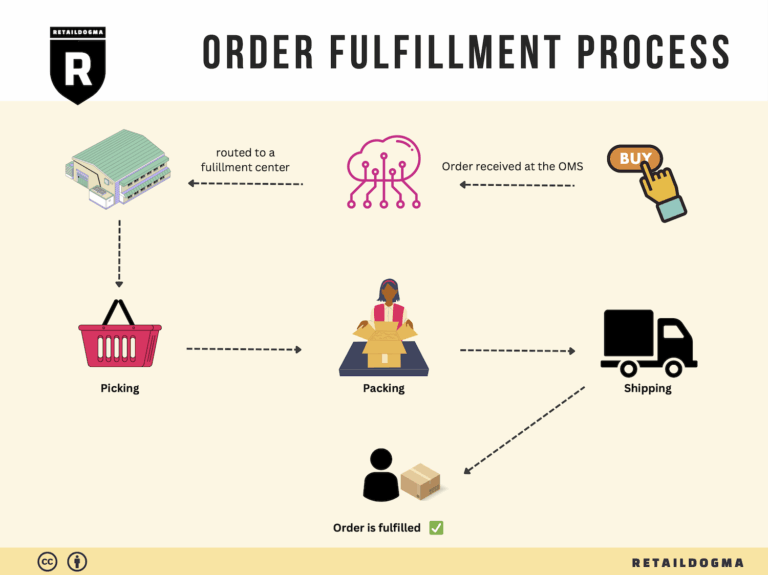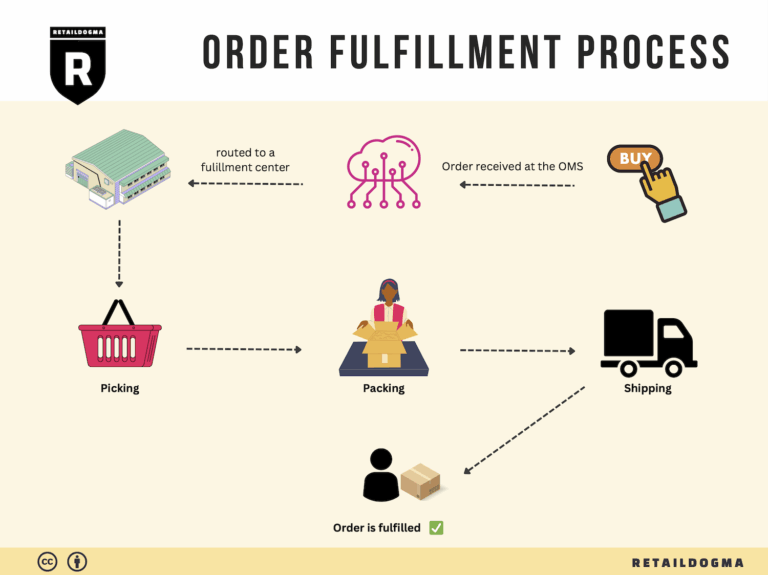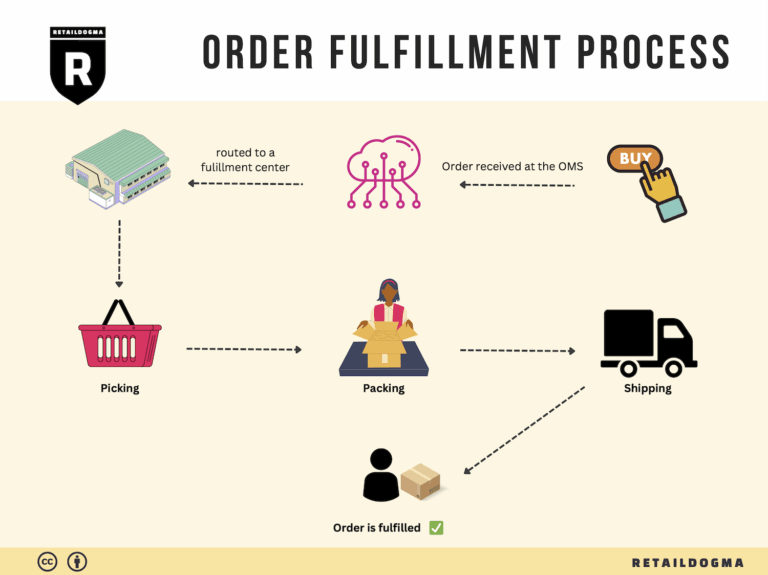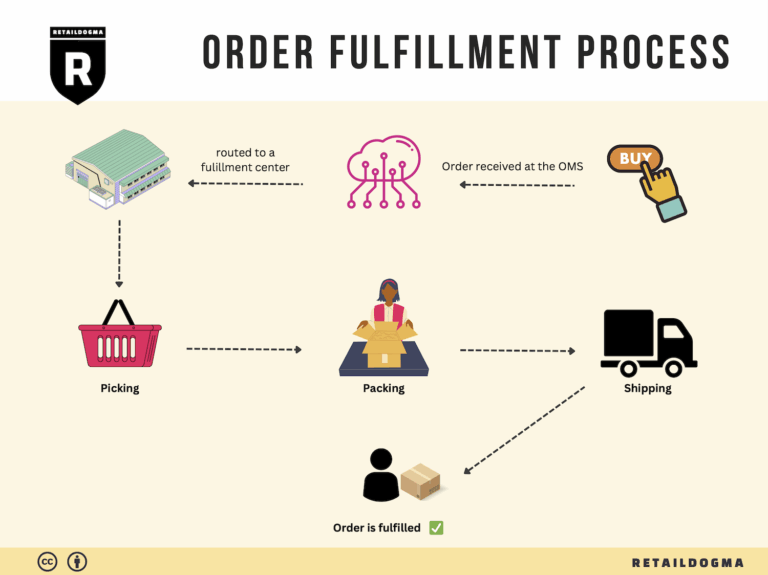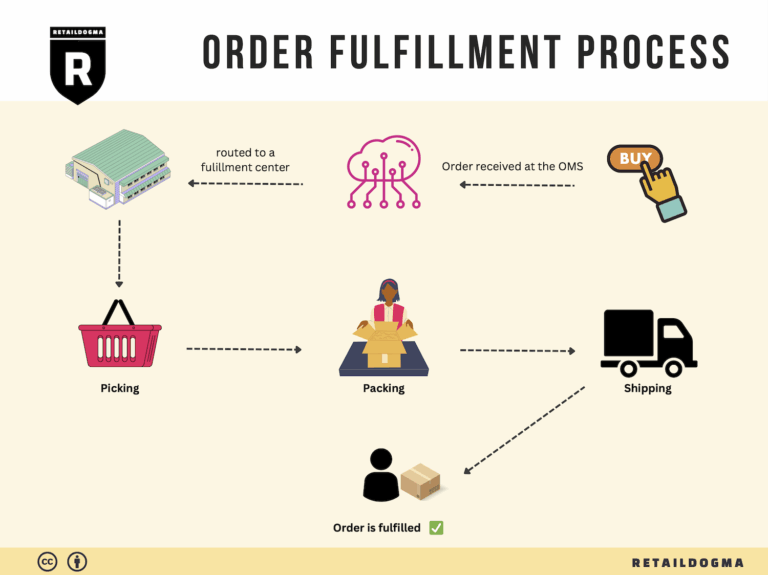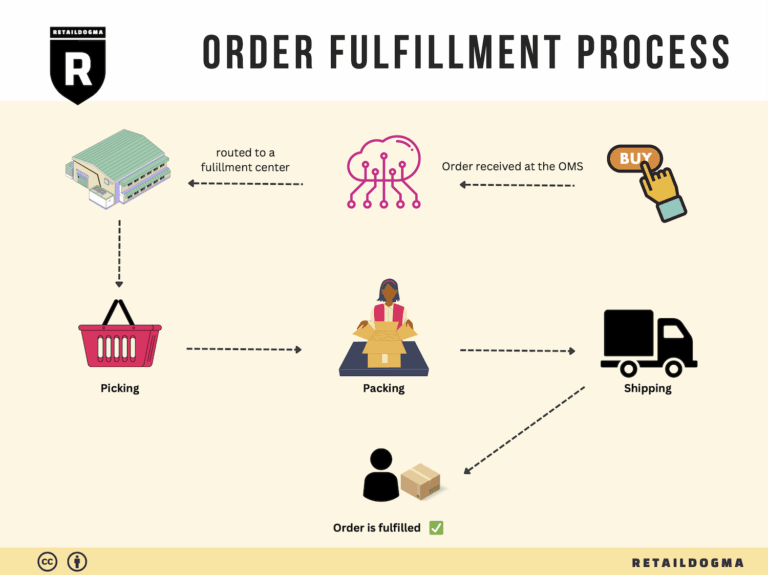How Order Fulfillment Works: A Step-by-Step Guide for Businesses
What is E-commerce Fulfillment? An Introduction for Growing Businesses
The Challenge of Order Fulfillment in E-commerce
As an e-commerce business owner, the excitement of growing sales can quickly turn into overwhelm when faced with the logistics of packing and shipping orders. The pressure to deliver products promptly and efficiently can detract from the core aspects of your business—like marketing, product development, and customer engagement. This is where the fulfillment process becomes crucial. Fulfillment, in its simplest terms, is the entire journey of getting a product from your inventory to the hands of your customer.
Understanding E-commerce Fulfillment
E-commerce fulfillment encompasses various models and methods, each tailored to meet the unique needs of different businesses. For instance, many growing businesses leverage Third-Party Logistics (3PL) providers, which manage warehousing and shipping on behalf of sellers. Alternatively, Fulfillment by Amazon (FBA) allows sellers to utilize Amazon’s extensive network, where they store products in Amazon fulfillment centers, and Amazon handles the picking, packing, and shipping.
This guide will delve into these different fulfillment models, providing insights into the core services they offer, such as inventory management, order processing, and returns handling. We will also discuss how to choose the right fulfillment partner that aligns with your business goals and customer expectations. Understanding pricing structures associated with these services is essential, as costs can vary significantly based on factors like order volume, product size, and service level.
Empowering Your Business Decisions
Ultimately, the goal of this guide is to empower you to make informed decisions about your logistics strategy. As you navigate the complexities of e-commerce fulfillment, understanding your options can help you streamline operations, enhance customer satisfaction, and, importantly, enable you to focus on scaling your business. By the end of this guide, you will be equipped with the knowledge to select the best fulfillment solution tailored to your needs, ensuring that your business not only meets customer expectations but exceeds them.
What You’ll Learn In This Guide
- What is E-commerce Fulfillment? An Introduction for Growing Businesses
- The Order Fulfillment Process: From ‘Buy’ Button to Customer’s Door
- Comparing Fulfillment Models: In-House vs. 3PL vs. Dropshipping
- A Deep Dive into Amazon FBA: Pros, Cons, and Who It’s For
- Core Services Offered by Fulfillment Centers
- How to Choose a Fulfillment Partner: A 6-Point Checklist
- Understanding Fulfillment Pricing: A Breakdown of Common Fees
- Frequently Asked Questions (FAQs) about Fulfillment
- Conclusion: Is Outsourcing Fulfillment the Right Move for Your Business?
- Important Disclaimer
The Order Fulfillment Process: From ‘Buy’ Button to Customer’s Door
1. Receiving Inventory
The order fulfillment process begins with receiving inventory at the fulfillment center. When a seller sends their products to an Amazon fulfillment center, those items undergo a systematic check-in process. Upon arrival, each product is scanned and sorted based on a unique identifier known as the SKU (Stock Keeping Unit). This identifier enables efficient tracking and management of inventory.
This step is crucial because accurate receiving ensures that the inventory is correctly accounted for and stored, which directly affects the subsequent steps in the fulfillment process. Any discrepancies at this stage can lead to inventory shortages or overages, complicating order fulfillment and potentially harming customer satisfaction. A well-organized receiving process also sets the foundation for effective inventory management and order accuracy.
2. Warehouse Storage
After products are received, they are placed into warehouse storage. Fulfillment centers utilize sophisticated inventory management systems to optimize space and ensure quick access to products. Items are typically stored in designated areas, which can vary based on size, weight, and type. This strategic organization allows for efficient inventory retrieval and minimizes the time it takes to process an order.
The importance of this step lies in its direct impact on order picking efficiency. The better organized the storage, the faster and more accurately orders can be fulfilled. Fulfillment centers often rely on ABC analysis, a technique that categorizes inventory based on value and turnover rate, ensuring that high-demand items are easily accessible.
3. Order Picking
Once a customer places an order, the next step in the fulfillment process is order picking. This involves retrieving the specific items from storage that correspond to the order. Fulfillment centers utilize pick lists, which are detailed instructions for warehouse workers outlining which items to collect and their respective locations. Advanced fulfillment centers may also employ technology such as handheld devices or automated systems to streamline this process.
Order picking is vital because it directly affects order accuracy and speed. The quicker and more accurately items are picked, the faster they can be packed and shipped, leading to improved customer satisfaction. An efficient picking process minimizes errors, reduces labor costs, and enhances overall operational efficiency.
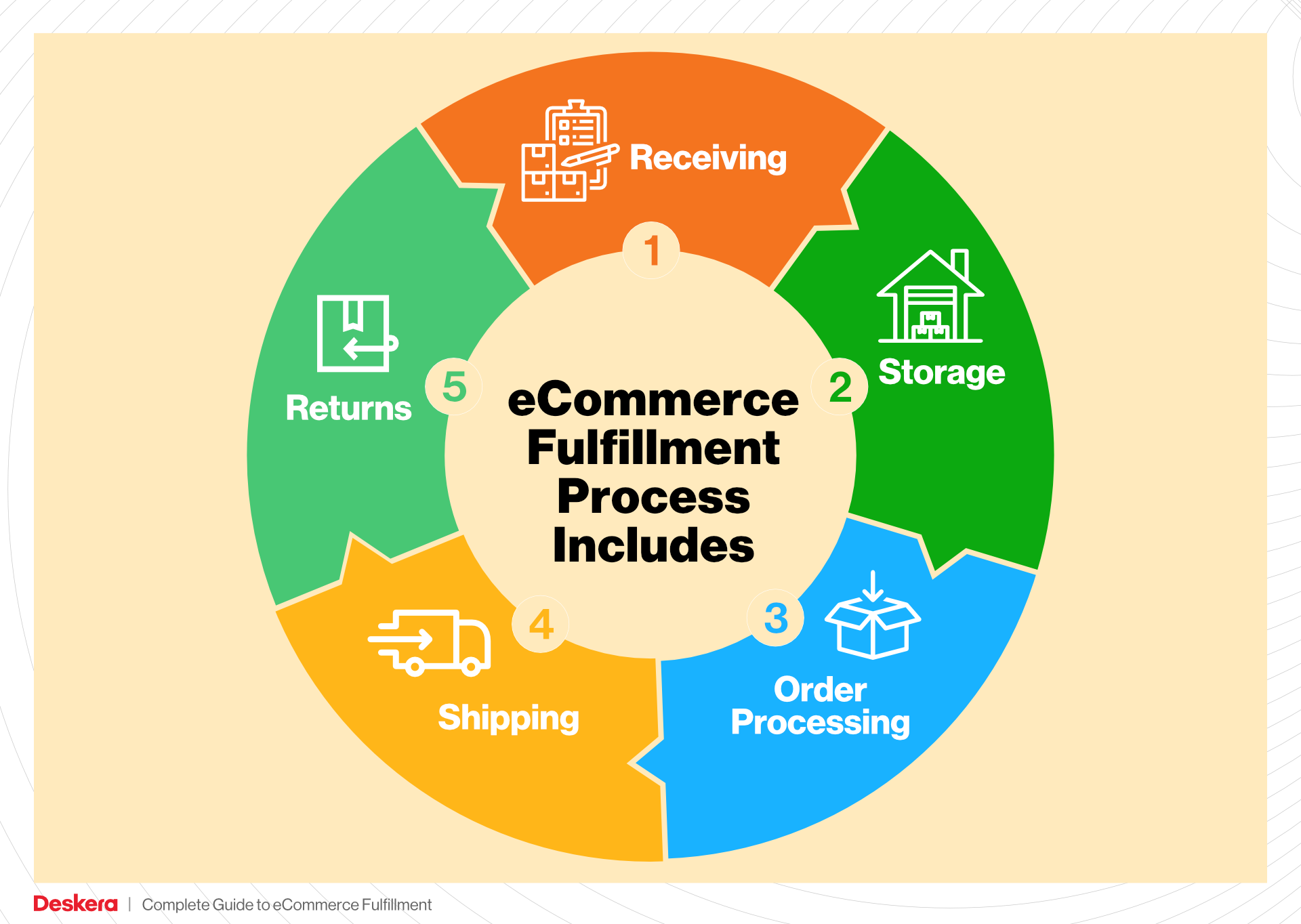
4. Order Packing
After items have been picked, they move to the order packing stage. Here, each item is carefully packed for shipment, considering factors such as size, weight, and fragility. Packing stations are equipped with various materials to ensure products are secured for transit while minimizing waste. This process often incorporates packaging optimization techniques to balance protection and cost-effectiveness.
The significance of packing cannot be overstated; it ensures that products arrive at the customer’s door in excellent condition. Proper packing helps reduce the likelihood of returns due to damage, which is not only costly but can also negatively impact seller ratings. Additionally, efficient packing processes contribute to overall shipping costs, making it essential for e-commerce businesses to fine-tune their packing strategies.
5. Shipping & Delivery
The final step in the order fulfillment process is shipping and delivery. Once packed, orders are labeled and sorted based on their destination and chosen shipping method. Fulfillment centers coordinate with various carriers to ensure timely delivery, often leveraging sophisticated shipping software that selects the best carrier and service level for each package.
This step is critical as it directly impacts the customer’s experience. Fast and reliable shipping is often a key differentiator in e-commerce, influencing customer satisfaction and repeat business. Understanding shipping zones and the logistics involved in last-mile delivery can help businesses optimize their shipping strategies, reduce costs, and improve delivery times.
In conclusion, each step in the order fulfillment process—from receiving inventory to shipping and delivery—is interconnected and essential for ensuring customer satisfaction. By understanding and optimizing these steps, e-commerce businesses can scale effectively and enhance their operational efficiency.
Comparing Fulfillment Models: In-House vs. 3PL vs. Dropshipping
Fulfillment Model Comparison Table
| Model | Who Handles Inventory | Best For (Business Stage) | Key Advantage | Key Disadvantage |
|---|---|---|---|---|
| In-House Fulfillment | The e-commerce business itself | Established businesses with stable sales | Complete control over inventory and fulfillment processes | High overhead costs and complexity |
| Third-Party Logistics (3PL) | A third-party logistics provider | Growing businesses looking to scale | Access to expertise and scalability without heavy investment | Less control over inventory management |
| Dropshipping | Supplier or manufacturer | Startups and new sellers | Low upfront costs and minimal risk | Lower profit margins and reliance on suppliers’ reliability |
In-House Fulfillment
In-house fulfillment involves managing the entire logistics process within the e-commerce business itself. This includes receiving, storing, picking, packing, and shipping products directly to customers. Companies that adopt this model typically have established sales channels and a stable inventory. The primary advantage of in-house fulfillment is the complete control it provides over inventory management and fulfillment processes. This control allows businesses to tailor their logistics operations to their unique needs, ensuring that customer expectations are met consistently. However, the downside is significant; maintaining an in-house operation can lead to high overhead costs associated with warehousing, staffing, and logistics technology. Additionally, as the business scales, the complexity of managing these operations can become overwhelming, diverting focus from core business activities.
Third-Party Logistics (3PL)
Third-party logistics (3PL) providers offer outsourced logistics services that can include everything from warehousing to shipping and even customer service. This model is ideal for growing businesses that want to scale quickly without the heavy investment required for in-house operations. By leveraging a 3PL, businesses can tap into the provider’s expertise in logistics, technology, and supply chain management, allowing them to focus on product development and sales. A key advantage of using 3PL services is the flexibility they offer; businesses can easily adjust their logistics needs based on demand fluctuations. However, the trade-off is a loss of direct control over inventory and fulfillment processes, which can lead to discrepancies in service quality and potential delays. This model is particularly effective for businesses looking to expand their reach without the burden of managing logistics directly.
Dropshipping
Dropshipping is a fulfillment model where the retailer does not keep goods in stock but instead transfers customer orders directly to a supplier or manufacturer, who then ships the products directly to the customer. This model is particularly appealing to startups and new sellers due to its low upfront costs and minimal risk; there’s no need to invest in inventory or warehousing. It allows entrepreneurs to test new products without the financial commitment of stock management. However, dropshipping comes with its own set of challenges. The most significant disadvantage is the typically lower profit margins, as suppliers often take a cut of the sales. Additionally, businesses relying on dropshipping are dependent on their suppliers for inventory management and shipping reliability, which can lead to inconsistent customer experiences if suppliers fail to deliver on time or maintain product quality.
Conclusion
Choosing the right fulfillment model is critical for e-commerce businesses aiming to scale effectively. Each model—whether in-house fulfillment, third-party logistics, or dropshipping—has its unique advantages and disadvantages. In-house fulfillment offers control but comes with high overhead costs, while 3PL provides scalability and expertise at the expense of some control. Dropshipping minimizes financial risk but can lead to lower margins and reliance on suppliers. Businesses should carefully evaluate their current stage, resources, and long-term goals to select the fulfillment strategy that best aligns with their operational needs and customer expectations.
A Deep Dive into Amazon FBA: Pros, Cons, and Who It’s For
Understanding Fulfillment by Amazon (FBA)
Fulfillment by Amazon (FBA) is a service that allows e-commerce sellers to store their products in Amazon’s vast fulfillment centers. Through FBA, Amazon takes on the responsibility of storing, picking, packing, and shipping these products directly to customers. This service is designed to simplify the logistics of selling on Amazon, enabling sellers to focus on other vital aspects of their businesses, such as product sourcing and marketing.
When sellers opt for FBA, they send their inventory to Amazon’s fulfillment centers, where it is stored until an order is placed. Once an order is received, Amazon’s system automatically selects the nearest fulfillment center to ship the product. This process not only speeds up delivery times but also enhances the customer experience, making it a popular choice among sellers.
How FBA Works
-
Inventory Storage: Sellers send their products to Amazon’s fulfillment centers, where they are checked in, stored, and organized. Amazon employs advanced inventory management systems to keep track of stock levels and product availability.
-
Order Fulfillment: When a customer places an order, Amazon picks the item from the inventory, packs it, and ships it directly to the customer. This process typically includes selecting the most appropriate carrier and service level for delivery.
-
Customer Service: Amazon also manages customer service for FBA orders, handling inquiries, returns, and refunds. This allows sellers to offload a significant portion of customer interactions and focus on growing their businesses.
-
Returns Processing: If a customer returns a product, Amazon processes the return on behalf of the seller, inspecting the item and deciding whether to restock, dispose of, or return it to the seller.
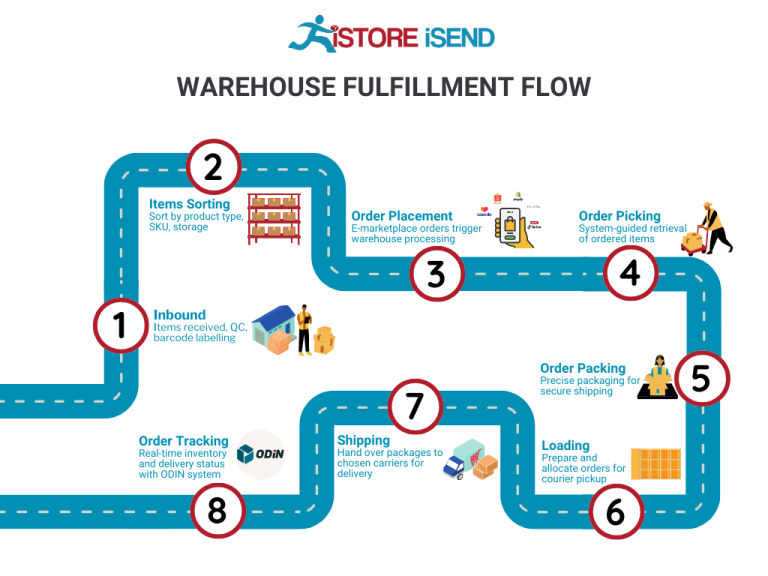
Pros of Using FBA
-
Prime Eligibility: Products fulfilled by Amazon are automatically eligible for Amazon Prime, which can significantly increase visibility and sales. Prime members are more likely to purchase items that qualify for their membership benefits, leading to higher conversion rates.
-
Customer Trust: Selling through FBA provides a level of credibility and trustworthiness that can enhance your brand’s reputation. Customers often prefer buying from sellers who use FBA due to the reliable shipping and customer service associated with Amazon.
-
Multi-Channel Fulfillment: FBA allows sellers to fulfill orders from other sales channels, such as their own websites or other marketplaces, using Amazon’s logistics network. This flexibility helps streamline operations and reduce shipping complexities.
-
Time Savings: By outsourcing storage, packing, and shipping to Amazon, sellers can save considerable time and effort, allowing them to focus on strategic activities like marketing, product development, and scaling their businesses.
Cons of Using FBA
-
High Fees: FBA comes with various fees, including storage fees and fulfillment fees based on the size and weight of products. These costs can add up quickly, particularly for sellers with large inventories or low-margin products. It’s crucial to analyze these fees against your profit margins to ensure that FBA is a financially viable option.
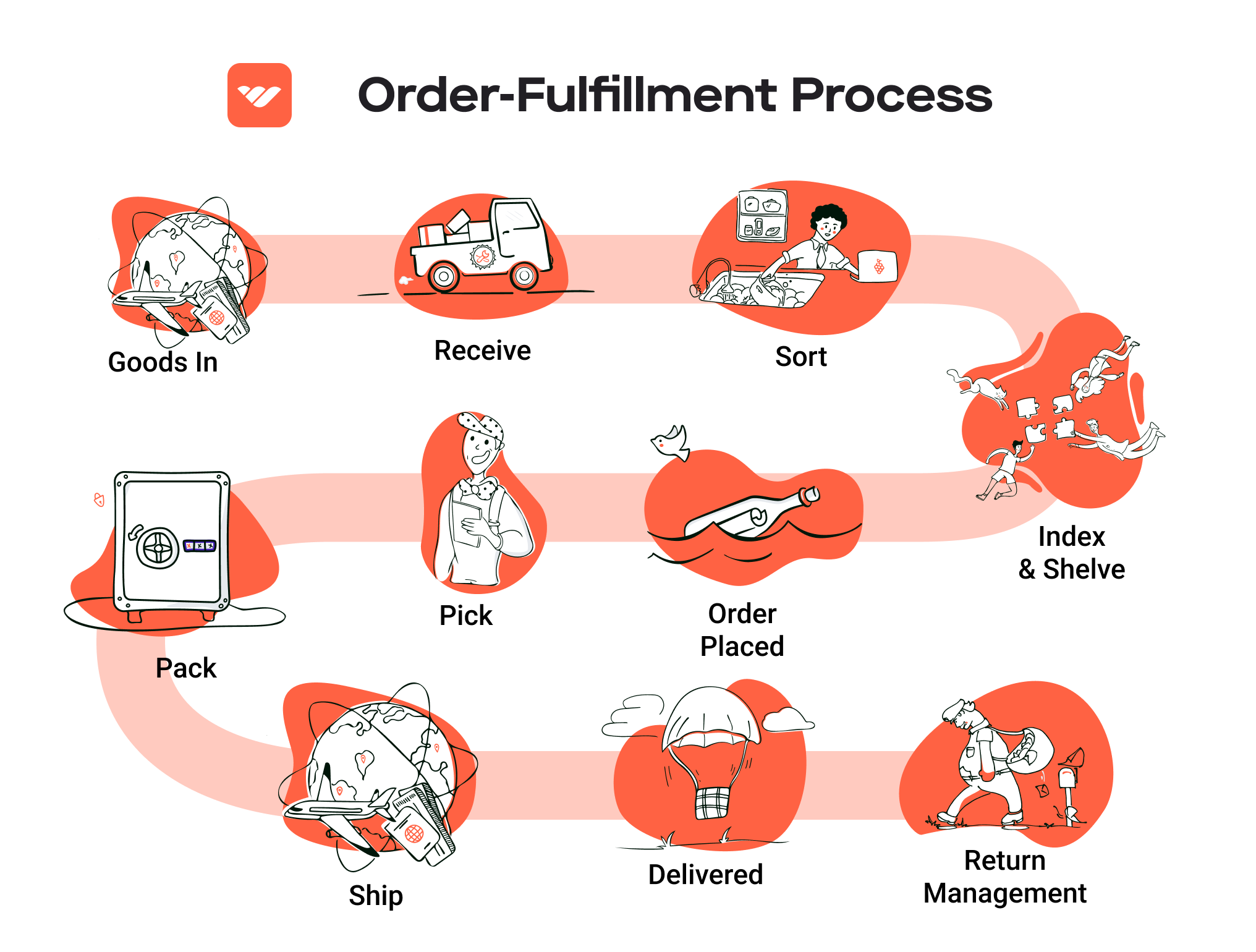
-
Strict Inventory Rules: Amazon has specific guidelines regarding inventory management, including labeling, packaging, and storage requirements. Failing to comply with these rules can result in additional fees or even the removal of your inventory from Amazon’s warehouses.
-
Commingling Risks: When using FBA, your inventory may be commingled with inventory from other sellers. While this can streamline the fulfillment process, it also poses risks if there are quality issues with other sellers’ products. If a customer receives a damaged or defective item, it can negatively impact your seller rating, even if the issue was not your fault.
-
Limited Control Over Fulfillment: By relying on Amazon for logistics, sellers may have less control over the fulfillment process, including shipping times and packaging quality. Any disruptions in Amazon’s operations can directly affect your business and customer satisfaction.
Who is FBA Best For?
FBA is particularly well-suited for e-commerce businesses looking to scale quickly without the overhead of managing their own logistics. Here are some types of sellers who might find FBA beneficial:
-
New Sellers: If you’re just starting your e-commerce business, FBA can provide immediate access to Amazon’s customer base and logistics network, helping you gain traction quickly.
-
High-Volume Sellers: Businesses that sell high volumes of products can benefit from the efficiency and scalability of FBA, allowing them to handle increased order volumes without significantly expanding their operational infrastructure.
-
Brands Seeking Trust: For brands that want to establish credibility and gain customer trust, FBA can serve as a strong selling point, given Amazon’s reputation for reliability.
-
Sellers with Limited Resources: If you lack the resources to manage warehousing, shipping, and customer service effectively, FBA allows you to focus on other aspects of your business while outsourcing logistics to a trusted partner.
In conclusion, Fulfillment by Amazon can be a powerful tool for e-commerce sellers looking to streamline operations and enhance customer satisfaction. However, it’s essential to weigh the pros and cons carefully and consider whether it aligns with your business goals and financial capabilities. By understanding how FBA works and its implications, sellers can make informed decisions that support their growth and success in the competitive e-commerce landscape.
Core Services Offered by Fulfillment Centers
Inventory Management & Warehousing
Inventory management and warehousing are fundamental services provided by fulfillment centers. These facilities offer a secure environment where e-commerce businesses can store their products until they are sold. Fulfillment centers utilize advanced inventory management systems that track product levels, monitor stock movements, and provide real-time data on inventory status.
Benefits:
1. Optimized Space Utilization: By leveraging the storage capabilities of fulfillment centers, e-commerce businesses can free up valuable space in their own operations. This is particularly beneficial for small and medium-sized enterprises that may lack the infrastructure for large-scale storage.
-
Accurate Inventory Tracking: Fulfillment centers employ sophisticated technology to manage inventory. This reduces the risk of stockouts or overstocking, enabling businesses to maintain optimal inventory levels. Accurate tracking also aids in better forecasting and planning.
-
Scalability: As a business grows, so does its inventory needs. Fulfillment centers provide the flexibility to scale storage capacity without the need for significant capital investment in real estate or warehousing equipment.
-
Reduced Operational Complexity: By outsourcing inventory management to a fulfillment center, e-commerce businesses can focus on core activities such as product development and marketing, rather than logistics and warehousing challenges.
Pick and Pack Services
Pick and pack services are critical components of the fulfillment process, where items are selected from inventory and prepared for shipping. When a customer places an order, fulfillment centers efficiently pick the correct items, pack them securely, and ship them directly to the customer.
Benefits:
1. Efficiency and Speed: Fulfillment centers employ streamlined processes and technology, such as barcode scanning and automated picking systems, to ensure that orders are fulfilled quickly and accurately. This leads to faster shipping times and improved customer satisfaction.
-
Cost-Effective Operations: By outsourcing pick and pack services, e-commerce businesses can reduce labor costs and overhead associated with in-house fulfillment. Fulfillment centers can handle high volumes of orders more efficiently, translating to lower per-order fulfillment costs.
-
Quality Control: Many fulfillment centers implement quality checks during the picking and packing process to ensure that the correct items are sent out in good condition. This minimizes errors and reduces the likelihood of returns due to incorrect shipments.
-
Custom Packaging Options: Fulfillment centers often provide various packaging solutions tailored to specific product requirements. This not only protects the products during transit but also enhances branding opportunities through customized packaging.
Kitting and Assembly
Kitting and assembly services involve bundling multiple products together into a single package or preparing items for sale by assembling them into a final product. This service is particularly beneficial for businesses that offer product bundles or require assembly before shipping.
Benefits:
1. Enhanced Product Offerings: Kitting allows e-commerce businesses to offer unique product combinations or promotional bundles that can attract more customers and increase average order value.
-
Time Savings: By outsourcing kitting and assembly to fulfillment centers, businesses can save time and resources that would otherwise be spent on in-house assembly processes. This allows teams to focus on other critical areas, such as marketing and customer engagement.
-
Improved Inventory Management: Kitting can help streamline inventory management by reducing the number of individual SKUs. Instead of managing multiple components, businesses can manage fewer bundled products, simplifying tracking and forecasting.
-
Flexibility and Customization: Fulfillment centers can quickly adapt to changes in product offerings or seasonal promotions, allowing businesses to respond to market demands without extensive lead times or operational disruptions.
Returns Management (Reverse Logistics)
Returns management, or reverse logistics, is a vital service offered by fulfillment centers that handles the processing of returned products. This includes receiving, inspecting, restocking, or disposing of items that customers return.
Benefits:
1. Streamlined Returns Process: Fulfillment centers simplify the returns process for e-commerce businesses by managing all aspects of returns, from logistics to customer communication. This can significantly enhance the customer experience and foster brand loyalty.
-
Cost Efficiency: Handling returns in-house can be labor-intensive and costly. By outsourcing this function, businesses can reduce overhead costs associated with managing returns while also benefiting from the fulfillment center’s expertise in handling reverse logistics.
-
Data Insights: Fulfillment centers provide valuable data regarding return reasons and trends, enabling businesses to analyze product performance and customer satisfaction. This information can guide product improvements and inventory decisions.
-
Sustainability Practices: Many fulfillment centers are adopting environmentally friendly practices in managing returns, such as recycling or refurbishing returned items. This not only helps reduce waste but can also enhance a brand’s sustainability image.
In summary, utilizing the core services offered by fulfillment centers can significantly streamline operations, reduce costs, and enhance customer satisfaction for e-commerce businesses looking to scale. By outsourcing these logistics functions, businesses can focus on growth and innovation while ensuring their fulfillment processes are efficient and effective.
How to Choose a Fulfillment Partner: A 6-Point Checklist
Location & Warehouse Network
Importance:
The geographic location of your fulfillment partner is critical for ensuring timely deliveries and minimizing shipping costs. A well-distributed warehouse network can significantly enhance your logistics efficiency by reducing transit times and improving customer satisfaction.
Questions to Ask:
– Where are the fulfillment centers located, and how does that align with your target customer base?
– Do they have multiple warehouses, and how strategically are they positioned to cover your key markets?
– What are their shipping times to major regions, and do they offer same-day or next-day delivery options?
Technology & Integrations
Importance:
In the fast-paced e-commerce environment, having a technology-driven fulfillment partner can streamline operations, reduce errors, and enhance inventory management. Look for partners that offer advanced integrations with your existing systems to facilitate seamless operations.
Questions to Ask:
– What technology platforms do they use for order processing, inventory management, and tracking?
– Can their systems integrate with your e-commerce platform (e.g., Shopify, Amazon, WooCommerce)?
– Do they provide real-time inventory tracking and reporting capabilities?
– What measures do they have in place for data security and compliance?
Specializations (e.g., Cold Storage, Oversized Items)
Importance:
Different businesses have unique fulfillment needs, especially if you handle specialized products such as perishables or large items. Selecting a partner with the necessary capabilities can help maintain product integrity and customer satisfaction.
Questions to Ask:
– Do they offer specialized services such as cold storage, hazardous materials handling, or oversized item fulfillment?
– What are their processes for handling returns, especially for specialized products?
– Can they accommodate custom packaging or kitting services tailored to your product requirements?
Scalability & Capacity
Importance:
As your business grows, your fulfillment needs will evolve. A partner that can scale with your business ensures that you won’t have to switch providers frequently, which can disrupt your operations and customer service.
Questions to Ask:
– What is their current capacity, and how do they handle peak seasons or sudden spikes in order volume?
– Can they accommodate seasonal fluctuations in inventory and order volume?
– What are their plans for future growth and capacity expansion?
Pricing and Contracts
Importance:
Understanding the cost structure is vital for maintaining profitability. Transparent pricing will help you avoid unexpected charges and budget effectively for your logistics expenses.
Questions to Ask:
– What is included in their pricing model (e.g., storage fees, pick-and-pack fees, shipping costs)?
– Are there any additional fees for services like returns processing or special handling?
– How do they handle pricing adjustments during contract renewal periods?
– Can they provide a detailed breakdown of all potential costs?
Customer Support & Reviews
Importance:
Reliable customer support is essential for resolving issues quickly and maintaining operational continuity. Checking reviews from other clients can provide insights into the partner’s reliability and service quality.
Questions to Ask:
– What levels of customer support do they offer (e.g., dedicated account managers, 24/7 support)?
– How do they handle service disruptions or operational challenges?
– Can you provide references or case studies from similar businesses in your industry?
– What is their track record for on-time deliveries and error rates in order fulfillment?
Conclusion
Choosing the right fulfillment partner is a pivotal decision that can significantly impact your e-commerce operations. By following this checklist and asking the right questions, you can ensure that your partner aligns with your business goals, meets your unique requirements, and supports your growth ambitions. Take the time to evaluate potential partners thoroughly, as the right choice will facilitate seamless logistics and enhance your customer experience.
Understanding Fulfillment Pricing: A Breakdown of Common Fees
Initial Setup Fees
When you begin using an Amazon Fulfillment Center (FBA), there may be initial setup fees associated with creating your seller account and getting your products ready for fulfillment. These fees can include charges for creating your seller account, setting up product listings, and any necessary training on how to use the FBA system.
While Amazon does not typically charge a flat initial setup fee, costs can arise from third-party services you might utilize for product photography, copywriting, or even consulting services to help you navigate the FBA landscape. It’s important to account for these potential costs in your overall budget as you scale your business.
Receiving Fees
Receiving fees are charged each time your inventory arrives at an Amazon fulfillment center. This fee covers the costs associated with unloading, inspecting, and storing your products. The fee structure can vary based on the size and weight of your products.
For example, smaller items may incur a lower receiving fee compared to larger or heavier items. Typically, these fees are calculated on a per-unit basis, meaning you will pay a fee for each item received at the fulfillment center. Familiarizing yourself with these costs is essential, as they can impact your overall profitability, especially if you plan to send large quantities of inventory.
Storage Fees (per pallet/bin)
Storage fees are assessed for the space your inventory occupies within the fulfillment center. Amazon typically charges storage fees on a monthly basis, and these fees can vary based on the time of year.
For instance, storage fees are generally higher during the holiday season (October through December) due to increased demand. The storage fees are often calculated per cubic foot or per pallet/bin, depending on how your products are stored. To minimize these fees, consider optimizing your inventory levels—sending in only what you need to meet demand while avoiding excess stock that could lead to higher storage costs.
Pick & Pack Fees (per item/order)
Pick and pack fees are charged each time an item is picked from storage and packed for shipment. This fee generally covers the labor involved in retrieving items from the shelves, packing them securely, and preparing them for shipping.
The cost structure for pick and pack fees can vary based on the size and weight of the item. For example, larger items may incur higher pick and pack fees compared to smaller items. Additionally, if your order includes multiple items, you may pay a fee for each item picked, which can quickly add up. Understanding these costs is crucial for pricing your products competitively while maintaining your profit margins.
Shipping Fees
Shipping fees are incurred when Amazon fulfills orders and ships products to customers. These fees depend on various factors, including the destination of the shipment, the weight of the package, and the shipping speed chosen by the customer (standard, two-day, etc.).
Amazon typically charges sellers based on the shipping service used and the weight of the package. The more you ship, the better you can negotiate rates with carriers, which can help reduce these costs over time. Being aware of your shipping fees is vital, as they can significantly affect your overall fulfillment expenses.
Tips for Getting an Accurate Quote
To obtain an accurate quote for your fulfillment costs, consider the following tips:
-
Use Amazon’s FBA Calculator: Amazon offers a free FBA calculator that allows you to input your product details to estimate fulfillment fees based on your specific items.
-
Understand Your Product Dimensions and Weight: Accurately measure and weigh your products to ensure that you receive precise estimates for receiving, storage, pick & pack, and shipping fees.
-
Monitor Seasonal Trends: Keep an eye on seasonal trends that may affect storage and shipping fees, particularly around major holidays when demand spikes.
-
Consult with Amazon Support: If you have specific questions or need clarification on fees, reaching out to Amazon Seller Support can provide insights tailored to your situation.
-
Review Third-Party Services: If you plan to use third-party logistics or fulfillment services, request detailed quotes from multiple providers to compare costs effectively.
By understanding these common fees and utilizing the tips above, you can better manage your fulfillment expenses and ensure your e-commerce business is set up for success as it scales.
Frequently Asked Questions (FAQs) about Fulfillment
1. What is an Amazon Fulfillment Center?
An Amazon Fulfillment Center is a large warehouse where Amazon stores products from third-party sellers who use the Fulfillment by Amazon (FBA) service. In these centers, Amazon handles the entire process of receiving, storing, picking, packing, and shipping products directly to customers, as well as managing customer service and returns.
2. How does an Amazon Fulfillment Center work?
Amazon Fulfillment Centers operate by receiving inventory from sellers, which is then scanned and stored. When a customer places an order, the fulfillment center retrieves the item, packs it, and ships it using Amazon’s logistics network. The centers also manage returns, ensuring they are processed efficiently.
3. What’s the difference between a warehouse and a fulfillment center?
While both warehouses and fulfillment centers store products, their functions differ significantly. A warehouse primarily focuses on storage, often for long-term inventory, whereas a fulfillment center is designed for quick order processing and shipping. Fulfillment centers also handle customer service and returns, making them integral to e-commerce operations.
4. What is FBA and how does it relate to fulfillment centers?
FBA stands for Fulfillment by Amazon, a service that allows sellers to store their products in Amazon’s fulfillment centers. Amazon then takes care of storage, order fulfillment, shipping, and customer service on behalf of the sellers, enabling them to reach a broader customer base and benefit from Amazon’s logistics capabilities.
5. How much do Amazon Fulfillment Centers charge?
The costs associated with Amazon Fulfillment Centers vary based on several factors, including the size and weight of the product, order handling, pick-and-pack fees, and monthly storage fees. Sellers should review the FBA fee structure in Seller Central to understand specific charges applicable to their products.
6. How can sellers find their nearest Amazon Fulfillment Center?
Sellers can locate the nearest Amazon Fulfillment Center by checking order details after making a purchase, looking at the shipping tracking information, searching online for local fulfillment centers, or reviewing local news articles about new Amazon facilities.
7. What are the benefits of using an Amazon Fulfillment Center?
Using an Amazon Fulfillment Center offers several advantages, including access to Amazon’s extensive logistics network, faster shipping times (often within 1-2 days), eligibility for Amazon Prime, and the ability to offload customer service and returns management, allowing sellers to focus on other aspects of their business.
8. What is a 3PL and how does it differ from Amazon Fulfillment?
A 3PL, or third-party logistics provider, is a service that manages logistics and supply chain functions for businesses. Unlike Amazon Fulfillment Centers, which are part of Amazon’s ecosystem, 3PLs can offer customized solutions across various platforms and marketplaces, providing flexibility for sellers who may not exclusively sell on Amazon.
9. What is the process for shipping products to an Amazon Fulfillment Center?
To ship products to an Amazon Fulfillment Center, sellers must prepare their items according to Amazon’s guidelines, create a shipping plan in Seller Central, and then package and label their products for shipment. Following these steps ensures compliance with Amazon’s requirements and facilitates smooth processing upon arrival.
10. How does Amazon handle returns in fulfillment centers?
When a customer returns a product, the return is processed at the Amazon Fulfillment Center. The returned item is inspected and either restocked, disposed of, or sent back to the seller based on its condition. This process streamlines returns management for sellers, allowing them to maintain a focus on sales and growth.
Conclusion: Is Outsourcing Fulfillment the Right Move for Your Business?
Evaluating the Benefits of Outsourcing Fulfillment
As you consider the potential of outsourcing your fulfillment needs, it’s essential to recognize the significant benefits that such a move can offer your business. First and foremost, utilizing a fulfillment service can save you invaluable time. By outsourcing the complexities of warehousing, inventory management, packing, and shipping, you can redirect your focus to core business activities like product development and marketing. This newfound time can be a game-changer for growth and innovation.
Scalability is another critical advantage. Partnering with a fulfillment center allows you to easily adapt to fluctuating order volumes without the burden of managing additional warehousing space or logistics on your own. Whether you experience seasonal spikes in sales or rapid growth, a capable fulfillment partner can scale operations to meet your needs efficiently.
Moreover, leveraging the expertise of a fulfillment service can enhance your operational efficiency. These partners typically have advanced technology and logistics solutions in place, ensuring faster order processing and improved accuracy. Their experience can also mitigate the risks associated with shipping and returns, ultimately enhancing customer satisfaction.
However, not all fulfillment partners are created equal. It’s crucial to conduct thorough research and choose a partner that aligns with your business goals and values. Evaluate their technology, service offerings, and customer service reputation to ensure they can support your growth trajectory.
Take Action Today
To determine if outsourcing fulfillment is the right move for your business, consider conducting an audit of your current shipping and logistics processes. Identify inefficiencies, pain points, and areas where a fulfillment partner could provide significant improvements. This strategic analysis will empower you to make informed decisions that align with your long-term business objectives. By embracing the right fulfillment solution, you position your business for sustainable growth and operational excellence.
Important Disclaimer
⚠️ Important Disclaimer
The information in this guide is for educational purposes. Fulfillment services, pricing, and platform features change frequently. Always conduct your own due diligence and consult with providers directly before making business decisions.
